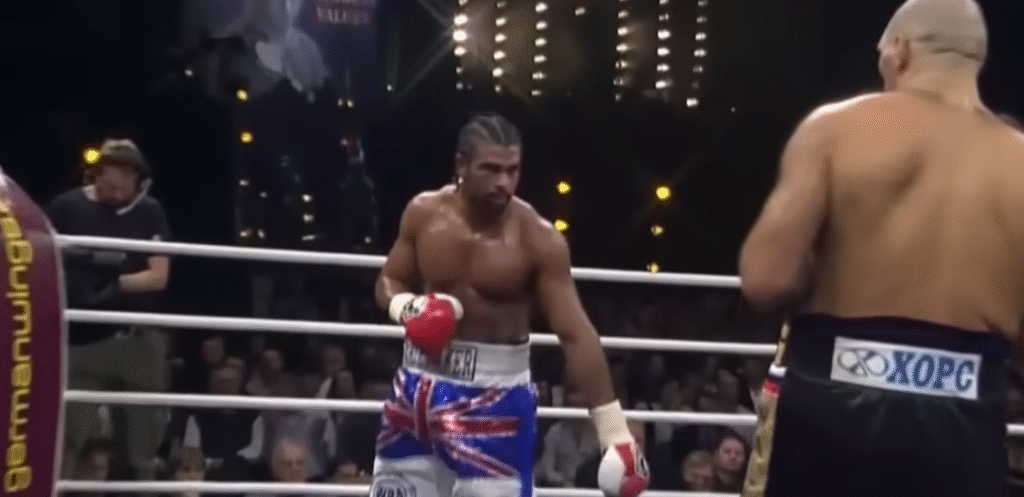Nikolai Valuev’s height is still a defining characteristic of his complex legacy by any measure. He dominated not only the boxing ring but every room he entered thanks to his height of 2.13 meters (7 feet). Valuev’s physical presence frequently left opponents mentally stunned before a single blow was delivered. Valuev was clearly and quantifiably larger than competitors like Vitali Klitschko (2.01 m), David Haye (1.91 m), and Ruslan Chagaev (1.85 m).
Valuev was frequently shown in photographs in almost surreal situations, sitting while still seeming taller than the people around him. Cameras could not capture the visual impact of his enormous head, unusually broad shoulders, and thick limbs. Commentators rarely missed an opportunity to praise his remarkable physique on fight nights, occasionally calling him a “human mountain” or “Goliath with gloves.” These are reflections of reality rather than exaggerations.
Valuev’s height, which is strikingly reminiscent of folklore giants, was not inherited from his parents, who were both only 1.65 meters tall. Rather, he credited a distant Tatar ancestor with his extraordinary size. His remarkable growth was given medical context by a subsequent diagnosis of acromegaly, which significantly enhanced our comprehension of the difficulties he encountered. He gained size from this condition, but it also caused health issues that ultimately led to his 2009 boxing retirement.
Valuev’s size was a tactical advantage in his heyday. He used his strength and reach to dominate the ring with little movement. In 2005, he defeated John Ruiz to become the heaviest and tallest heavyweight champion in history, a record that hasn’t been surpassed. That victory marked a sea change for the division as a whole, not just for Valuev. He changed what was regarded as a heavyweight fighter’s competitive build.
Biographical and Career Table
| Attribute | Details |
|---|---|
| Full Name | Nikolai Sergeyevich Valuev |
| Date of Birth | August 21, 1973 |
| Place of Birth | Saint Petersburg, Russia |
| Height | 2.13 m (7 ft 0 in) |
| Weight (Peak) | 151 kg (333 lbs) |
| Reach | 216 cm (85 in) |
| Stance | Orthodox |
| Nicknames | The Russian Giant, Beast from the East |
| Spouse | Galina Valueva |
| Children | Irina Valueva, Grisha Valuev |
| Political Office | Member of the State Duma |
| Years Active (Boxing) | 1993–2009 |
| Record | 53 Fights – 50 Wins (34 by KO), 2 Losses |
| Films | Kamennaya Bashka, 7 Zwerge, Gift with Character |
| Reference | Wikipedia – Nikolai Valuev |

Notably, there was controversy surrounding his 2008 fight with Evander Holyfield. Judges gave Valuev the victory even though Holyfield was faster and more active. The WBA launched an investigation as a result of the decision’s negative fan reaction. Nonetheless, Valuev’s height and weight—more than 310 pounds—had unquestionably affected the match’s dynamics from a physical perspective. Punches that would have stunned a smaller man were absorbed by his body.
By November 2009, Valuev was competing against the lighter and more nimble David Haye in a much-anticipated fight titled “David vs. Goliath.” Haye later acknowledged that it was harder than expected to get clean shots on such a large target, even though Valuev lost by majority decision. Valuev’s career came to an end after that fight because he was unable to manage his ongoing bone and joint problems, which were probably made worse by his size.
Valuev’s height continued to play a major role in his public persona even after he left the ring. He moved into movie parts where his physicality was either a major character trait or a visual joke. He portrayed a former boxer with memory loss in Kamennaya Bashka, a performance that won awards at the “Window to Europe” film festival. Later, when he hosted Good Night, Little Ones! on television, he developed into a charming character who contrasted his enormous physique with a quiet, gentle demeanor.
Valuev made his political debut in 2011 when he joined the State Duma as a member of the United Russia party. He was unmissable in political rooms full of suited bureaucrats, not only because of his background but also because he was 7 feet tall, making even tall coworkers look unimpressive. His speeches frequently touched on topics that were especially important to him, such as youth development and sports. In an effort to promote discipline and good health among young athletes, he founded the Nikolai Valuev Boxing School.
He kept growing his power by playing bandy, which is the second most popular sport in Russia. As the Russian Bandy Federation’s vice president, Valuev championed a sport that, like boxing, gains from physical strength. His entry into sports diplomacy solidified his standing in Russian society by demonstrating that size was a tool for social impact rather than merely a talking point.
Valuev’s height is still a hotly debated topic on the internet. People argue on forums and Reddit threads about whether he was actually 7 feet or if his aging and posture made him closer to 6’10”. In addition to photo breakdowns and speculative inches, side-by-side comparisons with Tyson Fury, Anthony Joshua, or even retired legends like Muhammad Ali are common. These continuing conversations demonstrate how iconic his body remains.
Discussions about athletes like Valuev have changed during the last ten years. These days, people talk about why his height matters rather than just how tall he is. Athletes of extreme size like Valuev carry both literal and symbolic weight as physicality increasingly shapes branding, public image, and media presence. His legacy is now shaped not just by his boxing victories but also by his ability to move into new fields like politics, television, and education without ever losing the aura that his height brought about.
